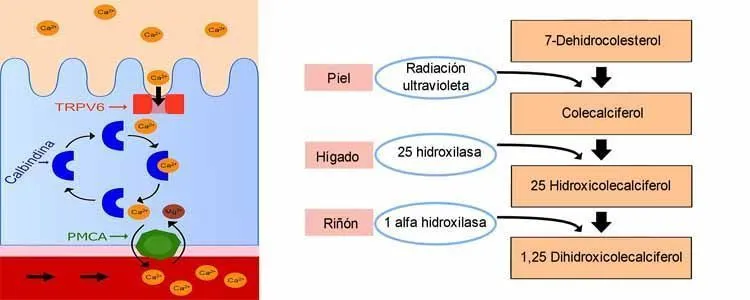Eating healthy is sometimes not enough to reach the necessary nutritional levels and keep our body strong. And it is that on many occasions, although we make a varied diet rich in fruits and vegetables, we may not be ingesting the necessary amounts of vitamins (such as vitamin D) that our body needs to find us at optimal levels.
Hypovitaminosis or deficiency of some vitamins is increasingly noticeable in people who either make unbalanced diets or in which their body is not able to assimilate equally all the vitamins and minerals it receives.
Therefore, let’s see what references we have of foods with vitamin D to increase the daily intake of them, in case we do not consume enough foods with vitamin D2 and vitamin D3
It can also happen that they are at a stage of their life in which an extra contribution of some of them is necessary, such as during the pregnancy or the menopause, in the case of women.
That is why it is important to restore them and be aware of what our deficiencies are to compensate for them with adequate intake of vitamins before it is too late.
The same goes for the vitamin d, essential to achieve appropriate levels of calcium in the bones and that they remain strong for longer, as well as vital in the formation of teeth and their good conservation.
Table of Contents
Vitamin D Function
Vitamin D, therefore, becomes fundamental in all stages of life: from the smallest, so that they grow with strong bones to the oldest, ages in which the bone structures begin to suffer, being able to be increasingly fragile, even reaching suffer from osteoporosis.
That’s why vitamin D, also known as Calciferol, is key since this fat-soluble vitamin, that is, it is dissolved in fats and oils, it is an essential substance for the good absorption of both calcium and phosphorus, two minerals responsible for the formation of bones.

Vitamin D2: Ergocalciferol
Vitamin D3: Cholecalciferol
Consequences of a lack of vitamin D
A lack of vitamin D can have many negative consequences for humans and have a serious impact on their health.
In adults, having less amount of vitamin D than necessary is associated with certain symptoms that interfere with a normal life such as suffering joint pain or feeling muscle fatigue as soon as you do moderate physical activity such as taking a walk, whose most serious consequences would be bone breaks or bone diseases such as osteoporosis.
In infants and toddlers the vitamin D deficiency Could generate in extreme cases in infantile rickets, a disease whose characteristics are bone deformations due to having softer bones than normal, causing a lot of exhaustion in those who suffer from it.
Recommended daily consumption
| Age | Women: μg/day (IU/day) | Men: mcg/day (IU/day) |
|---|---|---|
| 6-12 months | 10–25 μg (400–1,000 IU) | 10–25 μg (400–1,000 IU) |
| 1–3 years | 10 μg (400 IU) | 10 μg (400 IU) |
| 4–10 years | 0–10 μg (0–400 IU) | 0–10 μg (0–400 IU) |
| 11–17 years | 0–15 μg (0–600 IU) | 0–15 μg (0–600 IU) |
| 18-64 years | 0–10 μg (0–400 IU) | 0–10 μg (0–400 IU) |
| > 65 | 10 μg (400 IU) | 10 μg (400 IU) |
| Pregnant | 10 μg (400 IU) | n/a |
| Nursing | 10 μg (400 IU) | n/a |
Table reviewed by the Scientific Committee on Food.
Excess vitamin D
Be careful because an excessive amount of vitamin D supplement intake can also lead to negative consequences such as a high level of calcium in the blood, something that affects the normal heart rhythm.
Some symptoms that may appear are vomiting, nausea or the urge to urinate too often, this because the kidneys cannot properly remove excess calcium, which can end up causing calcium stones or stones.
Usually this only happens in very specific cases and only by the consumption of vitamin D in supplements, not by food or sun exposure.
Top foods with vitamin D

To prevent all these problems and always maintain strong and healthy bones, there is no doubt that we must consume foods with vitamin D.
The body produces vitamin D through sun exposure but because during the summer we use sunscreens and that in winter the exposure is lower, the contribution is not enough through this mechanism.
In addition, prolonged sun exposure without sunscreens also has its negative consequences, such as burns, premature aging of the skin, and even the development of skin cancer.
Let’s know the main foods with vitamin D, listed in order of highest to lowest concentration.
| Foods | Quantity (g) | Vitamin D (IU) |
|---|---|---|
| Cod liver oil | 1 tablespoon | 2300 |
| Salmon | 100 g | 624 |
| Sardines (can/fresh) | 100 g | 480 |
| Margarine | 100 g | 429 |
| Oysters | 6 oysters (medium) | 269 |
| Mushrooms, shitake | 4 fungi (medium) | 249 |
| Canned tuna, mackerel | 100 g | 230 |
| Shrimp, prawns | 100 g | 152 |
| Herring | 100 g | 120 |
| Evaporated milk | 1 cup | 97 |
| Whole milk, skim | 1 cup | 92 |
| Butter | 100 g | 56 |
| Milk cream | 100 g | 52 |
| Swiss cheese | 100 g | 44 |
| Parmesan cheese | 100 g | 28 |
| Egg yolk | 1 yolk | 25 |
| Camembert cheese | 100 g | 12 |
| Cheddar cheese | 100 g | 12 |
As we have already mentioned, vitamin D is fat-soluble and is available in some fats and oils, which makes it contain different foods that we are used to taking.
Oily fish
Fatty fish such as salmon, an oily fish highly appreciated for its multiple benefits such as its high content of omega-3 fatty acids, but it is also present in tuna, sardines or mackerel.
Seafood
Some seafood such as prawns or clams, which are also rich in iron, vitamin B12 or phosphorus.
Dairy products
Butter and other dairy products such as milk, yogurts and cheese, as long as they are made with whole milk, more caloric but also richer in vitamin D.
Egg yolk
The yolk of eggs, where this vitamin is exclusively concentrated. That means that by consuming only the white you will not be providing vitamin D to your body.
Avocados
Avocados, a tasty vegetable that works wonders in salads, toast and a lot of other dishes.
Mushrooms
Mushrooms and other mushrooms that have been grown through exposure to natural light and not artificial light, because they absorb vitamin D from the sun as we do through the skin.
Sun exposure
Not only from foods with vitamin D lives man and woman. Sun exposure also increases vitamin D levels in our body. However, it depends on the time of sun exposure, the type of skin (normal is skin III) and the month.
A sun of January, exposing 10% of the body (face and hands), with 130 minutes of sun exposure we will receive our recommended daily dose of vitamin D.
In April and July, with much more temperature due to the proximity of the sun, exposing 25% (short shirt, head, hands, etc.), with 10 minutes it is enough to receive the recommended dose.
In autumn, an average between summer and January, we would need 30 minutes with the same for the exposed body.
Vitamin D in infants

For babies, who are at a decisive stage of their growth and development, vitamin D is essential, because a correct amount of this vitamin prevents them from suffering from rickets or future dental problems such as cavities.
Like adults, they take vitamin D from sunlight, so it is usually recommended to take walks with them outdoors when the weather is good.
But they also receive it through food, such as breast milk, although artificial milk usually uses a formula enriched with vitamin D.
Capsules and add-ons
When we do not tolerate certain foods with vitamin D, (we can not always control the consumption we make of it from food), we can count on nutritional supplements helping us reach our goal is a more than effective way to do it.
These vitamin supplements have the utility of being easy to take in comfortable capsules and in the market there is a wide variety of options, brands and prices.

